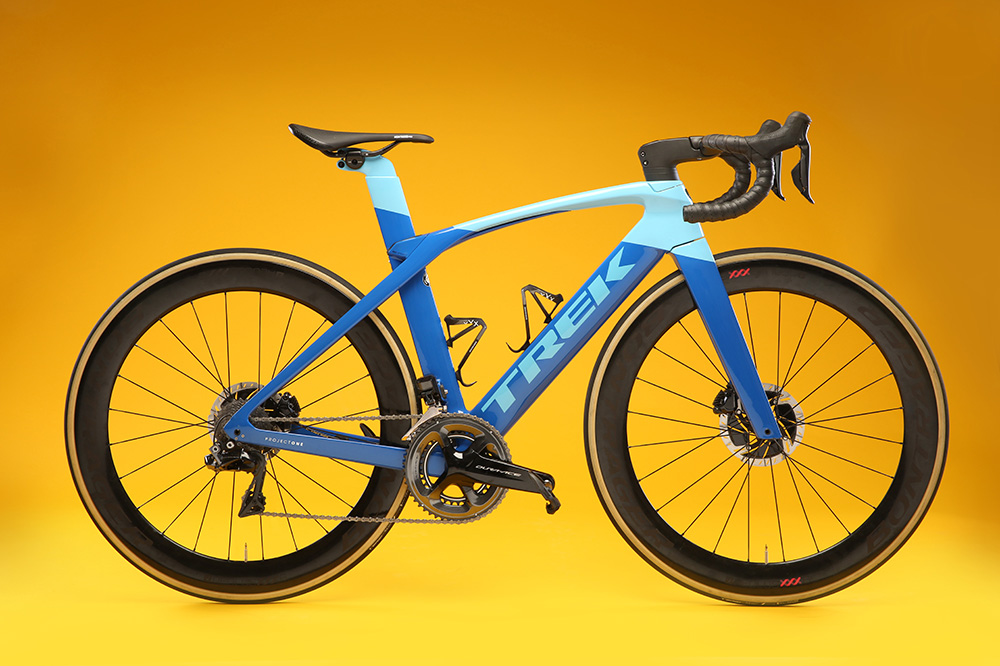Trek Madone range: Which model is right for you?


Despite being named afterLance Armstrong’s favourite training climb, the wind cheating Trek Madone is destined for flatter terrain. The aero bike within the brand's wide ranging collection received a major overhaul in its sixth iteration, launched for 2019.
Whilst the outline of the bike does not look dissimilar to the 2015 launched fifth version, a lot has changed when we explore the top end Trek Madone SLR in greater detail.
In the past, the Madone models were split into SLR (top end), SL (middle) and 9 Series (entry level) versions. For 2019, there is just one SL model, at £3600, and the rest are SLR - where a frameset is £4000.
The geometry has been adjusted as well. Trek splits its fits into 'H1' - low and agressive, and 'H2' - a little more relaxed.
>>> Trek Madone SLR 9 Disc review
For 2019, the surviving SL uses an 'H2' fit whilst the SLR offers an 'H1.5' geo. This was developed alongside Drops women's team, sponsored by Trek during 2018, and means there's a choice of low and high-stack stems provided to help riders fine tune the perfect fit.
In addition, the two piece aero bar can be tilted to +/-5 degrees, something that's very rarely possible on an integrated cockpit. The cables are hidden, which looks great and cuts resistance further, and the new models have 'Blendr' compatibility, which allows you to use Trek's system to mount your cycling computer and lights with minimal disruption.
Typically, aero bikes are not known for their comfortable ride quality. However, whilst Trek has offered a rear IsoSpeed decoupler on its Madone for some time, the new SLR provides an adjustable top tube decoupler.

The IsoSpeed system was introduced for the brand's endurance Domane, and creates flex in the frame which helps to dampen out road buzz. This new adjustable top tube version is tweaked via a 2.5mm Allem key and allows riders to switch between a level that's 17 per cent more compliance, vs one which is 21 per cent stiffer, than the previous 2015 model.
Moving the position of the decoupler reduces rebound caused by the flex, and it also allows for a better level of consistency across all frame sizes - formerly, smaller frame sizes suffered due to a shortening of the spring involved in the movement.
Continuing into the 2019 range is Trek's windtunnel tested Kammtail Virtual Foil (KVF) tube shaping, which employs a truncated-tail design to slice through the wind.
Trek no longer produces women's specific frames, instead offering the Madone SLR in women's and men's builds, the former of which comes specced with narrower handlebars and a women's saddle.
Trek Madone SLR & SL 2019 models

The SLR models differ from the sole surviving SL by virtue of the H1.5 fit, top tube IsoSpeed Decoupler, and the use of a higher end carbon - 700 OCLV (more on OCLV here).
There are rim and disc brake models on offer, and all versions useBontrager Aeolus Comp 5 wheels. If you want to personalise your Madone SLR, you can do so with a Project 1 paintjob, too.
The SL, by comparison, has the old IsoSpeed decoupler, H2 fit, and uses 500 OCLV carbon which will be fractionally heavier.
The spec options are:
- Trek Madone SL6 (rim): Shimano Ultegra, £3600
- Madone SLR 6 Disc: Shimano Ultegra, £5400 (£5950 with P1 paint)
- Madone SLR 6 (rim): Shimano Ultegra, £5500 (with P1 paint)
- Madone SLR 7 Disc: Shimano Ultegra Di2, £7550
- Madone SLR 8 Disc: Shimano Dura Ace, £7750
- Madone SLR 8 (rim): Shimano Dura Ace, £6750 (£7300 with P1 paint)
- Madone SLR 9 Disc: Shimano Ultegra Di2, £10,000 (£10,550 with P1 paint)
- Madone SLR 9 (rim): Shimano Ultegra Di2, £9550
- Madone SLR 9 eTap Disc: SRAM eTap, £10,550
- Madone SLR frameset: £4000
The latest race content, interviews, features, reviews and expert buying guides, direct to your inbox!
Michelle Arthurs-Brennan the Editor of Cycling Weekly website. An NCTJ qualified traditional journalist by trade, Michelle began her career working for local newspapers. She's worked within the cycling industry since 2012, and joined the Cycling Weekly team in 2017, having previously been Editor at Total Women's Cycling. Prior to welcoming her first daughter in 2022, Michelle raced on the road, track, and in time trials, and still rides as much as she can - albeit a fair proportion indoors, for now.
Michelle is on maternity leave from April 2025 until spring 2026.
